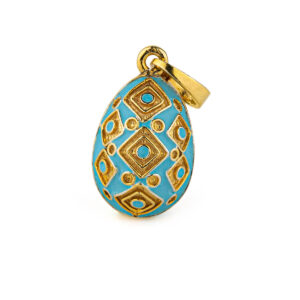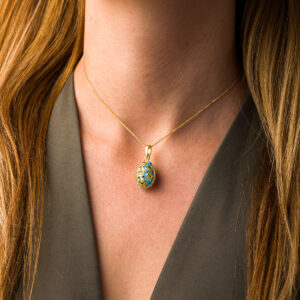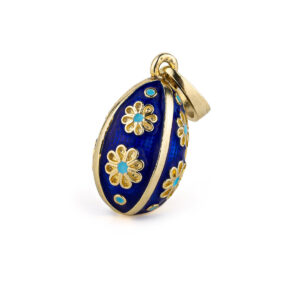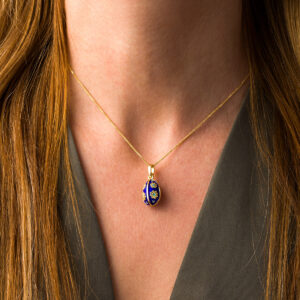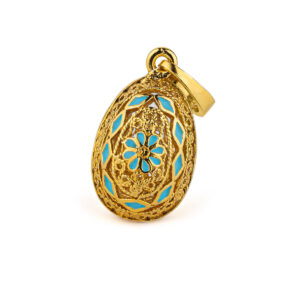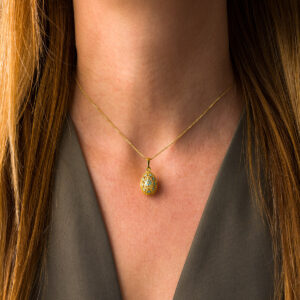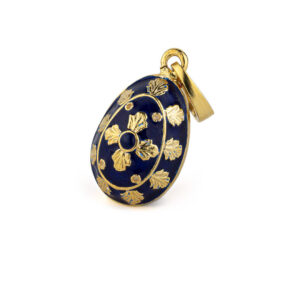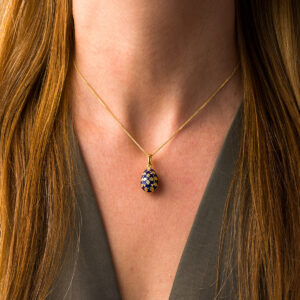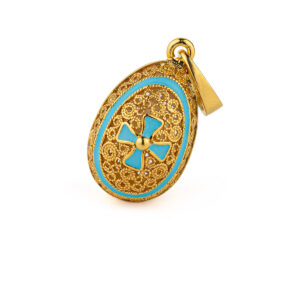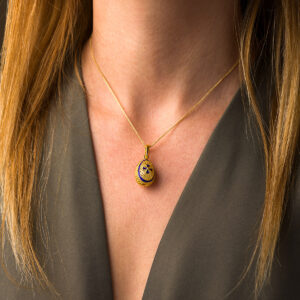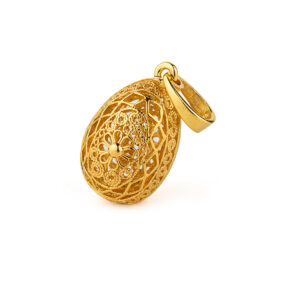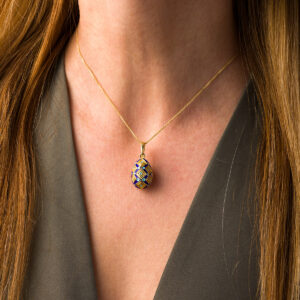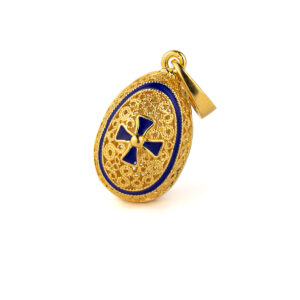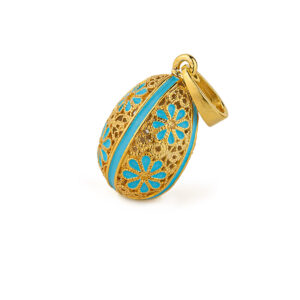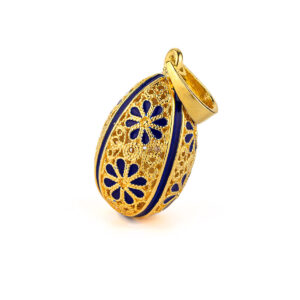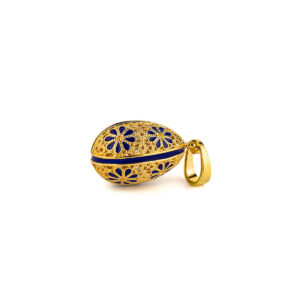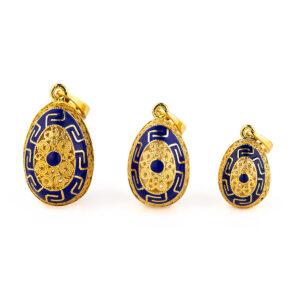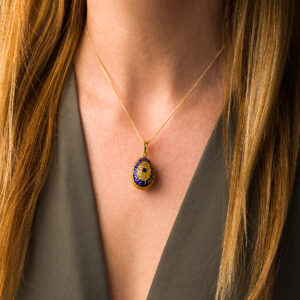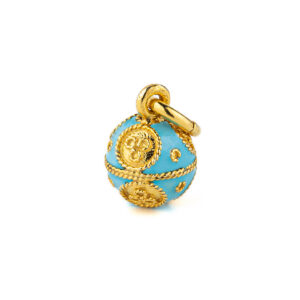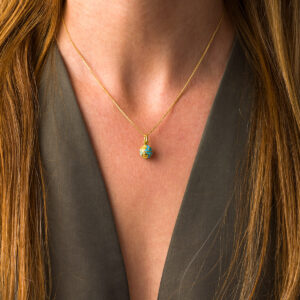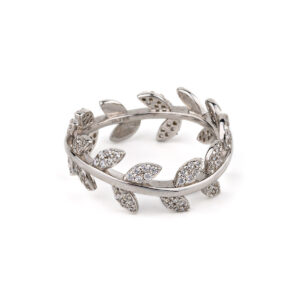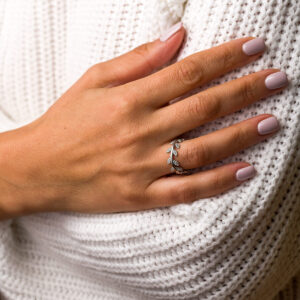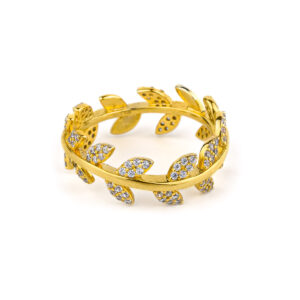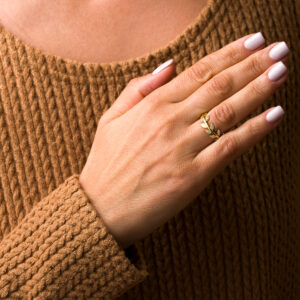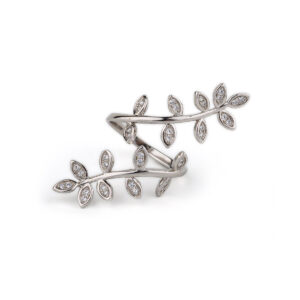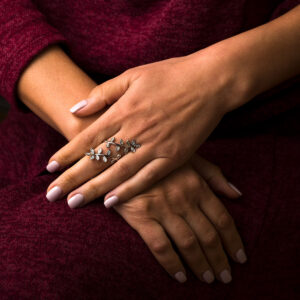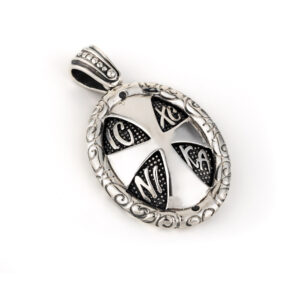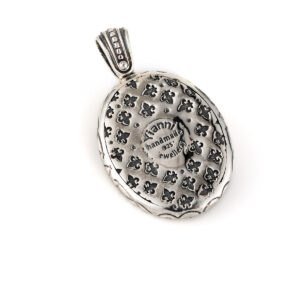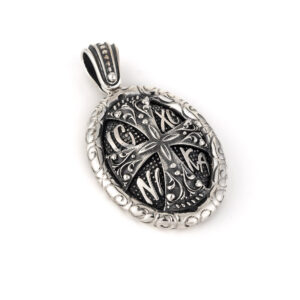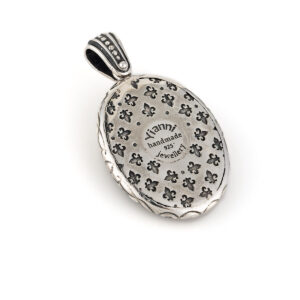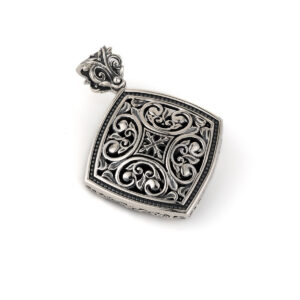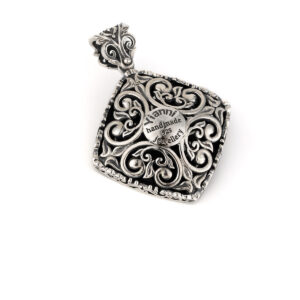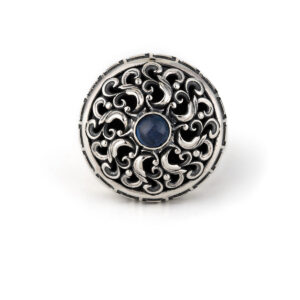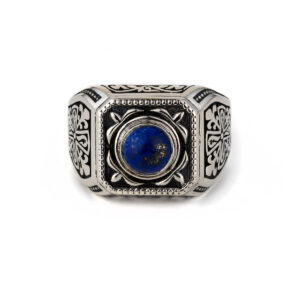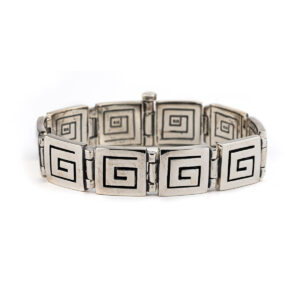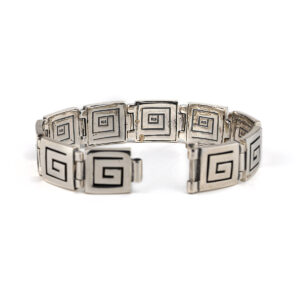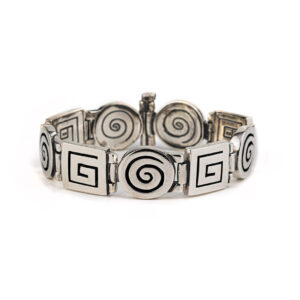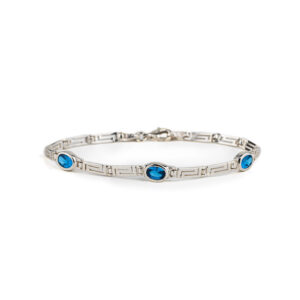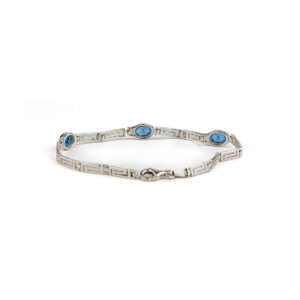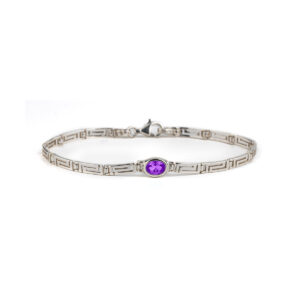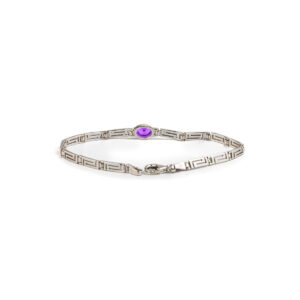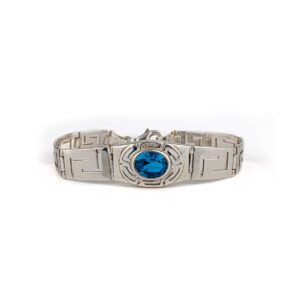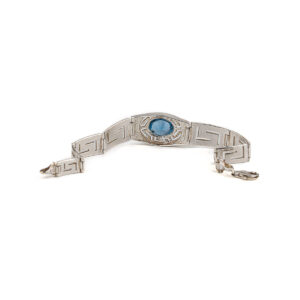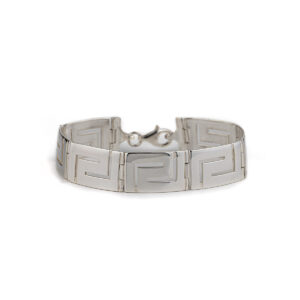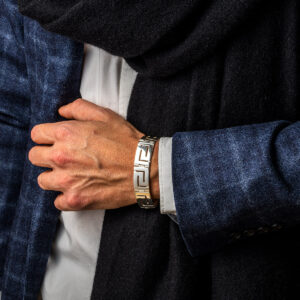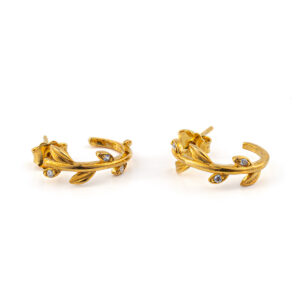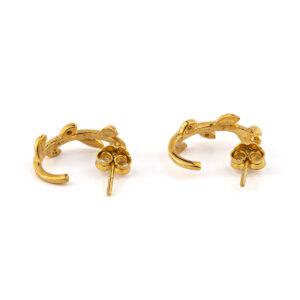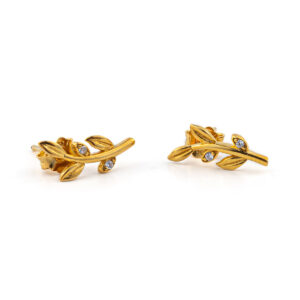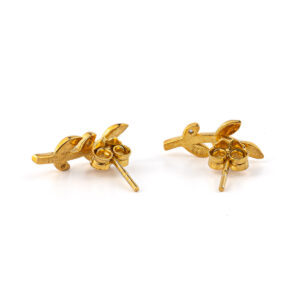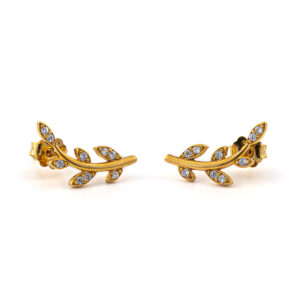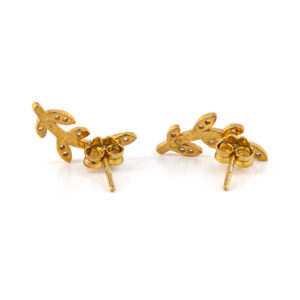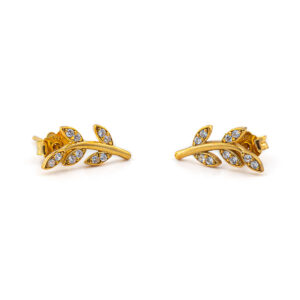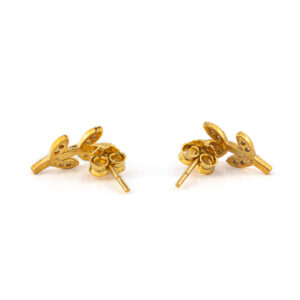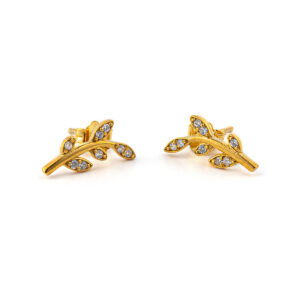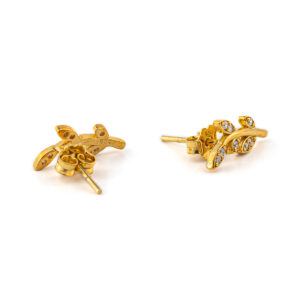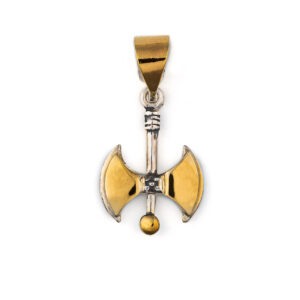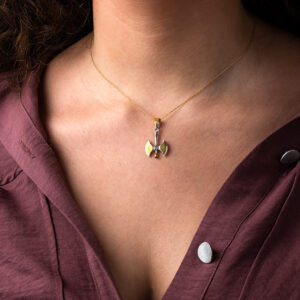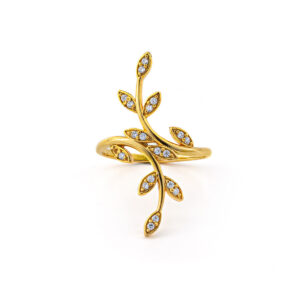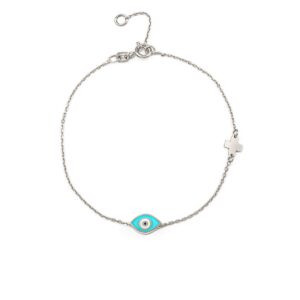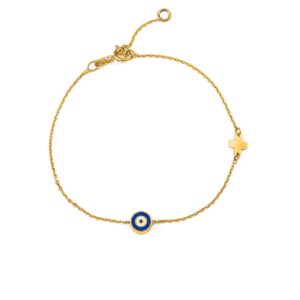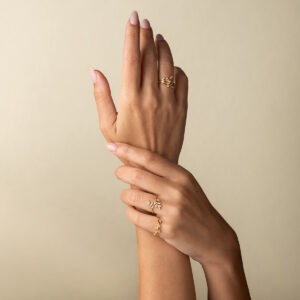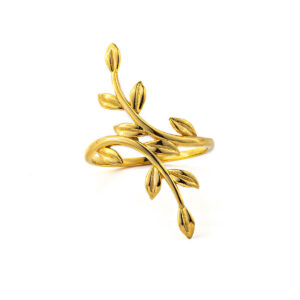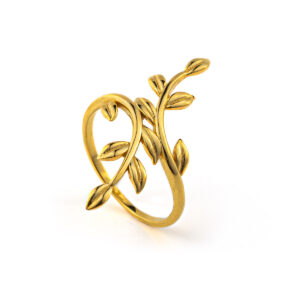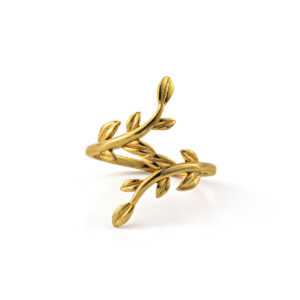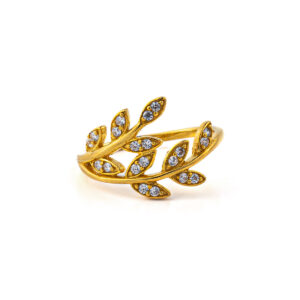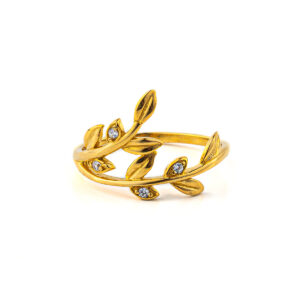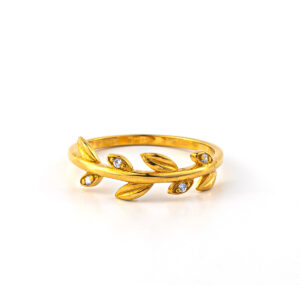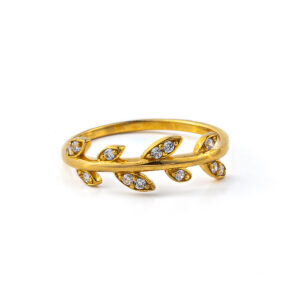Egg Enamel Pendant Necklace with Square Motifs – Sterling Silver Gold Plated
109,00€ – 129,00€A beautifully crafted egg-shaped pendant with square motifs, made of 925 sterling silver and gold plated.
The chain shown is included.
Used as a charm or as a pendant.
Pick up a beautiful Easter gift!
Made of 925 sterling silver and gold plated.
Egg Pendant Necklace with Flowers – Sterling Silver Gold Plated and Enamel
109,00€ – 129,00€A beautifully crafted egg-shaped pendant with flowers, made of 925 sterling silver, gold plated and enamel.
The chain shown is included.
Made of 925 sterling silver and gold plated.
Rosette Filigree Egg Pendant Necklace – Sterling Silver Gold Plated Enamel
109,00€ – 129,00€A beautifully crafted egg-shaped pendant with a rosette, made of 925 sterling silver and gold plated decorated with very detailed filigree motifs.
The chain shown is included.
Used as a charm or as a pendant.
Pick up a beautiful Easter gift!
Made of 925 sterling silver and gold plated.
Egg Cross Pendant Necklace with Enamel – Sterling Silver and Gold Plated
109,00€ – 129,00€A beautifully crafted egg-shaped pendant with a cross, made of 925 sterling silver and gold plated decorated with enamel.
Made of 925 sterling silver and gold plated.
The chain shown is included.
Egg Pendant Necklace with Cross – Sterling Silver Gold Plated with Turquoise Enamel
109,00€ – 129,00€A beautifully crafted egg-shaped pendant with a cross, made of 925 sterling silver and gold plated decorated with enamel and very detailed filigree.
Made of 925 sterling silver and gold plated.
The chain shown is included.
Filigree is a delicate kind of jewelry metalwork, made with tiny beads or twisted threads, or both in combination, soldered together or to the surface of an object of the same metal and arranged in artistic motifs. The art of filigree dates back to ancient history. The first of the found jewelry in this technique has been found in Mesopotamia and dates to thousands of years BC. In the ancient world and particularly in Asia Minor, this art grew at the highest level.
Fabergé egg is a jeweled egg created by the House of Fabergé, in St. Petersburg, Imperial Russia. Virtually all were manufactured under the supervision of Peter Carl Fabergé between 1885 and 1917,[citation needed] the most famous being the 50 “Imperial” eggs, 43 of which survive, made for the Russian Tsars Alexander III and Nicholas II as Easter gifts for their wives and mothers. The first Fabergé egg was crafted for Tsar Alexander III, who had decided to give his wife, Empress Maria Feodorovna, an Easter egg in 1885. Peter Carl Fabergé was a Russian jeweler best known for the famous Fabergé eggs made in the style of genuine Easter eggs, using precious metals and gemstones. He’s the founder of the famous jewelry legacy House of Fabergé. (Wikipedia)
Meander or Meandros design, one of the most historic symbols of the Greek World, also called Greek Key and symbolizes long life and eternity.
Rosette Filigree Egg Pendant Necklace – Sterling Silver and Gold Plated
109,00€ – 155,00€A beautifully crafted egg-shaped pendant with a rosette made of 925 sterling silver and gold plated decorated with very detailed filigree.
Made of 925 sterling silver and gold plated.
The chain shown is included.
Filigree is a delicate kind of jewelry metalwork, made with tiny beads or twisted threads, or both in combination, soldered together or to the surface of an object of the same metal and arranged in artistic motifs. The art of filigree dates back to ancient history. The first of the found jewelry in this technique has been found in Mesopotamia and dates to thousands of years BC. In the ancient world and particularly in Asia Minor, this art grew at the highest level.
Fabergé egg is a jeweled egg created by the House of Fabergé, in St. Petersburg, Imperial Russia. Virtually all were manufactured under the supervision of Peter Carl Fabergé between 1885 and 1917,[citation needed] the most famous being the 50 “Imperial” eggs, 43 of which survive, made for the Russian Tsars Alexander III and Nicholas II as Easter gifts for their wives and mothers. The first Fabergé egg was crafted for Tsar Alexander III, who had decided to give his wife, Empress Maria Feodorovna, an Easter egg in 1885. Peter Carl Fabergé was a Russian jeweler best known for the famous Fabergé eggs made in the style of genuine Easter eggs, using precious metals and gemstones. He’s the founder of the famous jewelry legacy House of Fabergé. (Wikipedia)
Meander or Meandros design, one of the most historic symbols of the Greek World, also called Greek Key and symbolizes long life and eternity.
Egg pendant necklace with Square Motifs – Sterling Silver Gold Plated with Enamel
109,00€ – 129,00€A beautifully crafted egg-shaped pendant, made of 925 sterling silver and gold plated decorated with enamel and square motifs.
Made of 925 sterling silver and gold plated.
The chain shown is included.
Egg Pendant Necklace with Cross – Sterling Silver Gold Plated and Enamel
109,00€ – 129,00€A beautifully crafted egg-shaped pendant with a cross, made of 925 sterling silver and gold plated decorated with enamel and very detailed filigree motifs.
Made of 925 sterling silver and gold plated.
The chain shown is included.
Filigree is a delicate kind of jewelry metalwork, made with tiny beads or twisted threads, or both in combination, soldered together or to the surface of an object of the same metal and arranged in artistic motifs. The art of filigree dates back to ancient history. The first of the found jewelry in this technique has been found in Mesopotamia and dates to thousands of years BC. In the ancient world and particularly in Asia Minor, this art grew at the highest level.
Fabergé egg is a jeweled egg created by the House of Fabergé, in St. Petersburg, Imperial Russia. Virtually all were manufactured under the supervision of Peter Carl Fabergé between 1885 and 1917,[citation needed] the most famous being the 50 “Imperial” eggs, 43 of which survive, made for the Russian Tsars Alexander III and Nicholas II as Easter gifts for their wives and mothers. The first Fabergé egg was crafted for Tsar Alexander III, who had decided to give his wife, Empress Maria Feodorovna, an Easter egg in 1885. Peter Carl Fabergé was a Russian jeweler best known for the famous Fabergé eggs made in the style of genuine Easter eggs, using precious metals and gemstones. He’s the founder of the famous jewelry legacy House of Fabergé. (Wikipedia)
Meander or Meandros design, one of the most historic symbols of the Greek World, also called Greek Key and symbolizes long life and eternity. The pattern with Meandro was used in antiquity to decorate the frieze of temples.
Filigree Egg Turquoise Pendant Necklace with Flowers – Sterling Silver Gold Plated
105,00€ – 135,00€The pendant is embellished with fine filigree and turquoise enamel in Faberge style.
Made of 925 sterling silver and gold plated.
The chain shown is included.
Filigree is a delicate kind of jewelry metalwork, made with tiny beads or twisted threads, or both in combination, soldered together or to the surface of an object of the same metal and arranged in artistic motifs. The art of filigree dates back to ancient history. The first of the found jewelry in this technique has been found in Mesopotamia and dates to thousands of years BC. In the ancient world and particularly in Asia Minor, this art grew at the highest level.
Fabergé egg is a jeweled egg created by the House of Fabergé, in St. Petersburg, Imperial Russia. Virtually all were manufactured under the supervision of Peter Carl Fabergé between 1885 and 1917,[citation needed] the most famous being the 50 “Imperial” eggs, 43 of which survive, made for the Russian Tsars Alexander III and Nicholas II as Easter gifts for their wives and mothers. The first Fabergé egg was crafted for Tsar Alexander III, who had decided to give his wife, Empress Maria Feodorovna, an Easter egg in 1885. Peter Carl Fabergé was a Russian jeweler best known for the famous Fabergé eggs made in the style of genuine Easter eggs, using precious metals and gemstones. He’s the founder of the famous jewelry legacy House of Fabergé. (Wikipedia)
Meander or Meandros design, one of the most historic symbols of the Greek World, also called Greek Key and symbolizes long life and eternity. The pattern with Meandro was used in antiquity to decorate the frieze of temples.
Filigree Egg Enamel Pendant Necklace with Flowers
105,00€ – 135,00€The pendant is embellished with fine filigree and blue enamel in Faberge style.
Made of 925 sterling silver and gold plated.
The chain shown is included.
Explore Byzantine Collection
Filigree is a delicate kind of jewelry metalwork, made with tiny beads or twisted threads, or both in combination, soldered together or to the surface of an object of the same metal and arranged in artistic motifs. The art of filigree dates back to ancient history. The first of the found jewelry in this technique has been found in Mesopotamia and dates to thousands of years BC. In the ancient world and particularly in Asia Minor, this art grew at the highest level.
Fabergé egg is a jeweled egg created by the House of Fabergé, in St. Petersburg, Imperial Russia. Virtually all were manufactured under the supervision of Peter Carl Fabergé between 1885 and 1917,[citation needed] the most famous being the 50 “Imperial” eggs, 43 of which survive, made for the Russian Tsars Alexander III and Nicholas II as Easter gifts for their wives and mothers. The first Fabergé egg was crafted for Tsar Alexander III, who had decided to give his wife, Empress Maria Feodorovna, an Easter egg in 1885. Peter Carl Fabergé was a Russian jeweler best known for the famous Fabergé eggs made in the style of genuine Easter eggs, using precious metals and gemstones. He’s the founder of the famous jewelry legacy House of Fabergé. (Wikipedia)
Meander Filigree Egg Pendant Necklace with Blue Enamel – Sterling Silver Gold Plated
109,00€ – 135,00€The pendant is embellished with fine filigree and blue enamel in Faberge style. Also, the pendant is decorated with a Meander design.
Made of 925 sterling silver and gold plated.
The chain shown is included.
Filigree is a delicate kind of jewelry metalwork, made with tiny beads or twisted threads, or both in combination, soldered together or to the surface of an object of the same metal and arranged in artistic motifs. The art of filigree dates back to ancient history. The first of the found jewelry in this technique has been found in Mesopotamia and dates to thousands of years BC. In the ancient world and particularly in Asia Minor, this art grew at the highest level.
Fabergé egg is a jeweled egg created by the House of Fabergé, in St. Petersburg, Imperial Russia. Virtually all were manufactured under the supervision of Peter Carl Fabergé between 1885 and 1917,[citation needed] the most famous being the 50 “Imperial” eggs, 43 of which survive, made for the Russian Tsars Alexander III and Nicholas II as Easter gifts for their wives and mothers. The first Fabergé egg was crafted for Tsar Alexander III, who had decided to give his wife, Empress Maria Feodorovna, an Easter egg in 1885. Peter Carl Fabergé was a Russian jeweler best known for the famous Fabergé eggs made in the style of genuine Easter eggs, using precious metals and gemstones. He’s the founder of the famous jewelry legacy House of Fabergé. (Wikipedia)
Meander or Meandros design, one of the most historic symbols of the Greek World, also called Greek Key and symbolizes long life and eternity. The pattern with Meandro was used in antiquity to decorate the frieze of temples.
Meander Filigree Egg Pendant Necklace with Turquoise Enamel – Sterling Silver Gold Plated
99,00€ – 125,00€The pendant is embellished with fine filigree and turquoise enamel in Faberge style. Also, the pendant is decorated with a Meander design.
Made of 925 sterling silver and gold plated.
The chain shown is included.
Filigree is a delicate kind of jewelry metalwork, made with tiny beads or twisted threads, or both in combination, soldered together or to the surface of an object of the same metal and arranged in artistic motifs. The art of filigree dates back to ancient history. The first of the found jewelry in this technique has been found in Mesopotamia and dates to thousands of years BC. In the ancient world and particularly in Asia Minor, this art grew at the highest level.
Fabergé egg is a jeweled egg created by the House of Fabergé, in St. Petersburg, Imperial Russia. Virtually all were manufactured under the supervision of Peter Carl Fabergé between 1885 and 1917,[citation needed] the most famous being the 50 “Imperial” eggs, 43 of which survive, made for the Russian Tsars Alexander III and Nicholas II as Easter gifts for their wives and mothers. The first Fabergé egg was crafted for Tsar Alexander III, who had decided to give his wife, Empress Maria Feodorovna, an Easter egg in 1885. Peter Carl Fabergé was a Russian jeweler best known for the famous Fabergé eggs made in the style of genuine Easter eggs, using precious metals and gemstones. He’s the founder of the famous jewelry legacy House of Fabergé. (Wikipedia)
Meander or Meandros design, one of the most historic symbols of the Greek World, also called Greek Key and symbolizes long life and eternity. The pattern with Meandro was used in antiquity to decorate the frieze of temples.
Egg Pendant Necklace with Enamel – Sterling Silver Gold Plated
60,00€ – 78,00€A beautifully crafted egg – shaped pendant, made of 925 sterling silver and gold plated with turquoise enamel.
Used as a charm or as a pendant.
Pick up a beautiful Easter gift!
The chain shown is included.
Olive Leaf Zircon Ring – 925 Sterling Silver
74,00€Ring inspired by the olive leaf symbol.
Made of 925 Sterling Silver.
The olive wreath also known as kotinos was the prize for the winner at the ancient Olympic Games. It was an olive branch, of the wild- olive tree that grew at Olympia, intertwined to form a circle or a horse-shoe. According to Pausanias it was introduced by Heracles as a prize for the running race winner to honour his father Zeus. In the ancient Olympic Games there were no gold, silver, or bronze medals. There was only one winner per event, crowned with an olive wreath made of wild-olive leaves from a sacred tree near the temple of Zeus at Olympia. Olive wreaths were given out during the 2004 Summer Olympics in Athens in honor of the ancient tradition, because the games were being held in Greece.
Olive Leaf Zircon Ring – 925 Sterling Silver and Gold Plated
74,00€Ring inspired by the olive leaf symbol.
Made of 925 Sterling Silver and Gold Plated
The olive wreath also known as kotinos was the prize for the winner at the ancient Olympic Games. It was an olive branch, of the wild- olive tree that grew at Olympia, intertwined to form a circle or a horse-shoe. According to Pausanias it was introduced by Heracles as a prize for the running race winner to honour his father Zeus. In the ancient Olympic Games there were no gold, silver, or bronze medals. There was only one winner per event, crowned with an olive wreath made of wild-olive leaves from a sacred tree near the temple of Zeus at Olympia. Olive wreaths were given out during the 2004 Summer Olympics in Athens in honor of the ancient tradition, because the games were being held in Greece.
Olive Leaves Ring – 925 Sterling Silver and Gold Plated
48,00€Ring inspired by the olive leaf symbol.
Made of 925 Sterling Silver and Gold Plated
The olive wreath also known as kotinos was the prize for the winner at the ancient Olympic Games. It was an olive branch, of the wild- olive tree that grew at Olympia,intertwined to form a circle or a horse-shoe. According to Pausanias it was introduced by Heracles as a prize for the running race winner to honour his father Zeus. In the ancient Olympic Games there were no gold, silver, or bronze medals. There was only one winner per event, crowned with an olive wreath made of wild olive leaves from a sacred tree near the temple of Zeus at Olympia. Olive wreaths were given out during the 2004 Summer Olympics in Athens in honor of the ancient tradition, because the games were being held in Greece.
Olive Leaf Branch Ring – 925 Sterling Silver
74,00€Ring inspired by the olive leaf symbol.
Made of 925 Sterling Silver.
The olive wreath also known as kotinos was the prize for the winner at the ancient Olympic Games. It was an olive branch, of the wild- olive tree that grew at Olympia,intertwined to form a circle or a horse-shoe. According to Pausanias it was introduced by Heracles as a prize for the running race winner to honour his father Zeus. In the ancient Olympic Games there were no gold, silver, or bronze medals. There was only one winner per event, crowned with an olive wreath made of wild-olive leaves from a sacred tree near the temple of Zeus at Olympia. Olive wreaths were given out during the 2004 Summer Olympics in Athens in honor of the ancient tradition, because the games were being held in Greece.
IC XC NIKA Cross Pendant Sterling Silver – Yianni Jewelry
289,00€This is a beautiful cross pendant.
Τhe cross is placed in an oval frame on which the ”ICXC NIKA” is engraved. IC XC NI KA symbol: IC XC for “Jesus Christ” and NI KA for “conquered”. The Byzantine symbol is also known as “En Touto Nika”.
Pendant inspired by Byzantine designs.
Made of 925⁰ sterling silver
Handmade item.
Silver creations of Yianni Jewelry, created by Garbis Khacherian, a silversmith trader since 1987.
ICXC NIKA Cross Pendant Sterling Silver – Yianni Jewelry
304,00€This is a beautiful imposed cross pendant.
Τhe cross is placed in an oval frame on which the ”ICXC NIKA” is engraved. IC XC NI KA symbol: IC XC for “Jesus Christ” and NI KA for “conquered”. The Byzantine symbol is also known as “En Touto Nika”.
Pendant inspired by Byzantine designs.
Silver oxidized finish.
Made of 925⁰ sterling silver
Handmade item
Silver creations of Yianni Jewelry, created by Garbis Khacherian, a silversmith trader since 1987.
Cross Filigree Pendant Sterling Silver – Yianni Jewelry
275,00€Made of 925° sterling silver.
Handmade Item.
Silver creations of Yianni Jewelry, created by Garbis Khacherian, a silversmith trader since 1987.
Greek Meander Floral Lapis Ring – Sterling Silver Yianni Jewelry
306,00€Τhis is an impressive oxidized ring made of sterling silver 925 and decorated with a lapis lazuli gemstone at the center.
Ιts large round surface in the shape of a dome has embossed designs.
On the perimeter of the ring, there is the design of the Meander, the most ancient Greek symbol, which is considered to be the symbol of Victory and Eternal Life.
Embossed designs are also on the side of the ring.
Handmade item.
Silver creations of Yianni Jewelry, created by Garbis Khacherian, a silversmith trader since 1987.
Explore Yianni Jewellery
Lapis Cross Signet Ring – Sterling Silver Yianni Jewelry
308,00€Made of 925⁰ sterling silver
Silver creations of Yianni Jewelry, created by Garbis Khacherian, a silversmith trader since 1987.
Explore Yianni Jewellery
Greek Key Meander Link Bracelet – 925 Sterling Silver
360,00€Bracelet with Greek key motif.
Made of 925⁰ sterling silver.
Handmade item.
Greek Key Spiral Link Bracelet – 925 Sterling Silver
315,00€Bracelet with Greek key motif.
Made of 925⁰ sterling silver.
Handmade item.
Greek Key Link Bracelet with Blue Zircon – 925 Sterling Silver
110,00€Bracelet with Greek key.
Made of 925⁰ sterling silver with zircon.
Handmade item.
Greek Key Meander Zircon Bracelet – 925 Sterling Silver
75,00€Bracelet with Greek key motif.
Made of 925⁰ sterling silver with zircon.
Handmade item.
Greek Key Meander Bracelet with Zircon – 925 Sterling Silver
192,00€Bracelet with Greek key motif.
Made of 925⁰ sterling silver with zircon.
Handmade item.
Greek Key Link Bracelet – 925 Sterling Silver
112,00€ – 275,00€Sterling Silver Bracelet with Greek key motif.
Handmade item.
Made in 925⁰ sterling silver.
Explore Meandros Collection
Meandros design is a decorative border constructed from a continuous line, shaped into a repeated motif. Such a design is also called the Greek fret or Greek key design, although these are modern designations. On the one hand, the name “meander” recalls the twisting and turning path of the Meander River in Asia Minor, and on the other hand, as Karl Kerenyi pointed out, “the meander is the figure of a labyrinth in linear form” the meaning is that there is no beginning and no end in some cases so it becomes the symbol of long life and eternity.
Olive Leaves Earrings with Zircon – 14K Solid Yellow Gold
620,00€Earrings inspired by the olive leaf symbol.
Made of 14k gold with zircon.
The olive wreath also known as kotinos was the prize for the winner at the ancient Olympic Games. It was an olive branch, of the wild- olive tree that grew at Olympia, intertwined to form a circle or a horse-shoe. According to Pausanias it was introduced by Heracles as a prize for the running race winner to honour his father Zeus. In the ancient Olympic Games there were no gold, silver, or bronze medals. There was only one winner per event, crowned with an olive wreath made of wild-olive leaves from a sacred tree near the temple of Zeus at Olympia. Olive wreaths were given out during the 2004 Summer Olympics in Athens in honor of the ancient tradition, because the games were being held in Greece.
Olive Leaf Earrings with Zircon – 14K Solid Yellow Gold
428,00€Earrings inspired by the olive leaf symbol.
Made of 14k gold with zircon.
The olive wreath also known as kotinos was the prize for the winner at the ancient Olympic Games. It was an olive branch, of the wild- olive tree that grew at Olympia,intertwined to form a circle or a horse-shoe. According to Pausanias it was introduced by Heracles as a prize for the running race winner to honour his father Zeus. In the ancient Olympic Games there were no gold, silver, or bronze medals. There was only one winner per event, crowned with an olive wreath made of wild-olive leaves from a sacred tree near the temple of Zeus at Olympia. Olive wreaths were given out during the 2004 Summer Olympics in Athens in honor of the ancient tradition, because the games were being held in Greece.
Olive Leaf Zircon Earrings – 14K Solid Yellow Gold
514,00€Earrings inspired by the olive leaf symbol.
Made of 14k gold with zircon.
The olive wreath also known as kotinos was the prize for the winner at the ancient Olympic Games. It was an olive branch, of the wild- olive tree that grew at Olympia,intertwined to form a circle or a horse-shoe. According to Pausanias it was introduced by Heracles as a prize for the running race winner to honour his father Zeus. In the ancient Olympic Games there were no gold, silver, or bronze medals. There was only one winner per event, crowned with an olive wreath made of wild-olive leaves from a sacred tree near the temple of Zeus at Olympia. Olive wreaths were given out during the 2004 Summer Olympics in Athens in honor of the ancient tradition, because the games were being held in Greece.
Leaf Zircon Earrings – 14K Solid Yellow Gold
568,00€Earrings inspired by the olive leaf symbol.
Made of 14k gold with zircon.
The olive wreath also known as kotinos was the prize for the winner at the ancient Olympic Games. It was an olive branch, of the wild- olive tree that grew at Olympia,intertwined to form a circle or a horse-shoe. According to Pausanias it was introduced by Heracles as a prize for the running race winner to honour his father Zeus. In the ancient Olympic Games there were no gold, silver, or bronze medals. There was only one winner per event, crowned with an olive wreath made of wild-olive leaves from a sacred tree near the temple of Zeus at Olympia. Olive wreaths were given out during the 2004 Summer Olympics in Athens in honor of the ancient tradition, because the games were being held in Greece.
Leaf Earrings with Zircon – 14K Solid Yellow Gold
428,00€Earrings inspired by the olive leaf symbol.
Made of 14k gold with zircon.
The olive wreath also known as kotinos was the prize for the winner at the ancient Olympic Games. It was an olive branch, of the wild- olive tree that grew at Olympia,intertwined to form a circle or a horse-shoe. According to Pausanias it was introduced by Heracles as a prize for the running race winner to honour his father Zeus. In the ancient Olympic Games there were no gold, silver, or bronze medals. There was only one winner per event, crowned with an olive wreath made of wild-olive leaves from a sacred tree near the temple of Zeus at Olympia. Olive wreaths were given out during the 2004 Summer Olympics in Athens in honor of the ancient tradition, because the games were being held in Greece.
Minoan Double Axe Pendant – 14K Yellow Gold and Sterling Silver
135,00€ – 235,00€Pendant inspired by the Minoan double axe, known as labrys.
Made of 14K Gold and Sterling Silver
Handmade in Greece.
The chain shown is included.
Explore Heritage Collection
History
Labrys is, according to Plutarch, Minoan word for the double headed axe called in Greek πέλεκυς (pélekus). In ancient Crete, the double axe was an important sacred symbol of the Minoan religion. In Crete it never accompanies male gods, but always female goddesses. It seems that it associated with the worship of Mother Earth or Great Goddess.
Olive Leaf Ring with Zircon – 14K Solid Yellow Gold
582,00€Ring inspired by the olive leaf symbol.
Made of 14k gold with zircon.
The olive wreath also known as kotinos was the prize for the winner at the ancient Olympic Games. It was an olive branch, of the wild- olive tree that grew at Olympia, intertwined to form a circle or a horse-shoe. According to Pausanias it was introduced by Heracles as a prize for the running race winner to honour his father Zeus. In the ancient Olympic Games there were no gold, silver, or bronze medals. There was only one winner per event, crowned with an olive wreath made of wild-olive leaves from a sacred tree near the temple of Zeus at Olympia. Olive wreaths were given out during the 2004 Summer Olympics in Athens in honor of the ancient tradition because the games were being held in Greece.
Evil Eye Turquoise Enamel Bracelet with Cross – 925 Sterling Silver
45,00€Evil eye bracelet with enamel.
Made of 925 sterling silver.
Evil Eye
The symbol and superstition of the evil eye is one of the strongest symbolic images in the world. The earliest known evidence for belief in the evil eye goes back to ancient Greece and Rome. It is suppose to wear off evil to anyone who wears it and various cultures believe in that, however in Greece it’s blue because at that time blue eyes were not so common and were thought to give the evil eye, so the blue is like a mirror to them. Nowadays it’s widely known and has became a trend.
Evil Eye Blue Enamel Bracelet with Cross – Sterling Silver and Gold Plated
45,00€Evil eye bracelet with enamel.
Made of 925 sterling silver and gold plated
Evil Eye
The symbol and superstition of the evil eye is one of the strongest symbolic images in the world. The earliest known evidence for belief in the evil eye goes back to ancient Greece and Rome. It is suppose to wear off evil to anyone who wears it and various cultures believe in that, however in Greece it’s blue because at that time blue eyes were not so common and were thought to give the evil eye, so the blue is like a mirror to them. Nowadays it’s widely known and has became a trend.
Round Enamel Evil Eye Bracelet with Cross – Sterling Silver and Plated
45,00€Evil eye bracelet with blue enamel.
Made of 925 sterling silver and gold plated.
Evil Eye
The symbol and superstition of the evil eye is one of the strongest symbolic images in the world. The earliest known evidence for belief in the evil eye goes back to ancient Greece and Rome. It is supposed to wear off evil to anyone who wears it and various cultures believe in that, however in Greece it’s blue because at that time blue eyes were not so common and were thought to give the evil eye, so the blue is like a mirror to them. Nowadays it’s widely known and has become a trend.
Leaf Adjustable Ring with Zircon – 14K Solid Yellow Gold
528,00€Ring inspired by the olive leaf symbol.
Made of 14k gold with zircon.
The olive wreath also known as kotinos was the prize for the winner at the ancient Olympic Games. It was an olive branch, of the wild- olive tree that grew at Olympia, intertwined to form a circle or a horse-shoe. According to Pausanias it was introduced by Heracles as a prize for the running race winner to honour his father Zeus. In the ancient Olympic Games there were no gold, silver, or bronze medals. There was only one winner per event, crowned with an olive wreath made of wild-olive leaves from a sacred tree near the temple of Zeus at Olympia. Olive wreaths were given out during the 2004 Summer Olympics in Athens in honor of the ancient tradition, because the games were being held in Greece.
Olive Leaf Branch Ring – 18K Solid Yellow Gold
756,00€Ring inspired by the olive leaf symbol.
Made of 18k gold.
The olive wreath also known as kotinos was the prize for the winner at the ancient Olympic Games. It was an olive branch, of the wild- olive tree that grew at Olympia, intertwined to form a circle or a horse-shoe. According to Pausanias it was introduced by Heracles as a prize for the running race winner to honour his father Zeus. In the ancient Olympic Games there were no gold, silver, or bronze medals. There was only one winner per event, crowned with an olive wreath made of wild-olive leaves from a sacred tree near the temple of Zeus at Olympia. Olive wreaths were given out during the 2004 Summer Olympics in Athens in honor of the ancient tradition, because the games were being held in Greece.
Olive Leaf Branch Ring – 14K Solid Yellow Gold
560,00€Ring inspired by the olive leaf symbol.
Made of 14k gold.
The olive wreath also known as kotinos was the prize for the winner at the ancient Olympic Games. It was an olive branch, of the wild- olive tree that grew at Olympia, intertwined to form a circle or a horse-shoe. According to Pausanias it was introduced by Heracles as a prize for the running race winner to honour his father Zeus. In the ancient Olympic Games there were no gold, silver, or bronze medals. There was only one winner per event, crowned with an olive wreath made of wild-olive leaves from a sacred tree near the temple of Zeus at Olympia. Olive wreaths were given out during the 2004 Summer Olympics in Athens in honor of the ancient tradition because the games were being held in Greece.
Olive Leaf Ring with White Zircon – 14K Solid Yellow Gold
602,00€Ring inspired by the olive leaf symbol.
Made of 14k gold with zircon.
The olive wreath also known as kotinos was the prize for the winner at the ancient Olympic Games. It was an olive branch, of the wild- olive tree that grew at Olympia, intertwined to form a circle or a horse-shoe. According to Pausanias it was introduced by Heracles as a prize for the running race winner to honour his father Zeus. In the ancient Olympic Games there were no gold, silver, or bronze medals. There was only one winner per event, crowned with an olive wreath made of wild-olive leaves from a sacred tree near the temple of Zeus at Olympia. Olive wreaths were given out during the 2004 Summer Olympics in Athens in honor of the ancient tradition because the games were being held in Greece.
Olive Branch Ring – 18K Solid Yellow Gold
680,00€Ring inspired by the olive leaf symbol.
Made of 18k gold.
The olive wreath also known as kotinos was the prize for the winner at the ancient Olympic Games. It was an olive branch, of the wild- olive tree that grew at Olympia, intertwined to form a circle or a horse-shoe. According to Pausanias it was introduced by Heracles as a prize for the running race winner to honour his father Zeus. In the ancient Olympic Games there were no gold, silver, or bronze medals. There was only one winner per event, crowned with an olive wreath made of wild-olive leaves from a sacred tree near the temple of Zeus at Olympia. Olive wreaths were given out during the 2004 Summer Olympics in Athens in honor of the ancient tradition because the games were being held in Greece.
Olive Branch Ring – 14K Solid Yellow Gold
514,00€Ring inspired by the olive leaf symbol.
Made of 14k gold.
The olive wreath also known as kotinos was the prize for the winner at the ancient Olympic Games. It was an olive branch, of the wild- olive tree that grew at Olympia, intertwined to form a circle or a horse-shoe. According to Pausanias it was introduced by Heracles as a prize for the running race winner to honour his father Zeus. In the ancient Olympic Games there were no gold, silver, or bronze medals. There was only one winner per event, crowned with an olive wreath made of wild-olive leaves from a sacred tree near the temple of Zeus at Olympia. Olive wreaths were given out during the 2004 Summer Olympics in Athens in honor of the ancient tradition because the games were being held in Greece.
Olive Leaf Ring with Zircon – 14K Solid Yellow Gold
578,00€Ring inspired by the olive leaf symbol.
Made of 14k gold with zircon.
The olive wreath also known as kotinos was the prize for the winner at the ancient Olympic Games. It was an olive branch, of the wild- olive tree that grew at Olympia, intertwined to form a circle or a horse-shoe. According to Pausanias it was introduced by Heracles as a prize for the running race winner to honour his father Zeus. In the ancient Olympic Games there were no gold, silver, or bronze medals. There was only one winner per event, crowned with an olive wreath made of wild-olive leaves from a sacred tree near the temple of Zeus at Olympia. Olive wreaths were given out during the 2004 Summer Olympics in Athens in honor of the ancient tradition because the games were being held in Greece.
Leaf Zircon Ring – 14K Solid Yellow Gold
494,00€Ring inspired by the olive leaf symbol.
Made of 14k gold with zircon.
The olive wreath also known as kotinos was the prize for the winner at the ancient Olympic Games. It was an olive branch, of the wild- olive tree that grew at Olympia, intertwined to form a circle or a horse-shoe. According to Pausanias it was introduced by Heracles as a prize for the running race winner to honour his father Zeus. In the ancient Olympic Games there were no gold, silver, or bronze medals. There was only one winner per event, crowned with an olive wreath made of wild-olive leaves from a sacred tree near the temple of Zeus at Olympia. Olive wreaths were given out during the 2004 Summer Olympics in Athens in honor of the ancient tradition because the games were being held in Greece.
Leaf Zircon Ring – 14K Solid Yellow Gold
418,00€Ring inspired by the olive leaf symbol.
Made of 14k gold with zircon.
The olive wreath also known as kotinos was the prize for the winner at the ancient Olympic Games. It was an olive branch, of the wild- olive tree that grew at Olympia, intertwined to form a circle or a horse-shoe. According to Pausanias it was introduced by Heracles as a prize for the running race winner to honour his father Zeus. In the ancient Olympic Games there were no gold, silver, or bronze medals. There was only one winner per event, crowned with an olive wreath made of wild-olive leaves from a sacred tree near the temple of Zeus at Olympia. Olive wreaths were given out during the 2004 Summer Olympics in Athens in honor of the ancient tradition because the games were being held in Greece.
Leaf Ring with Zircon – 14K Solid Yellow Gold
418,00€Ring inspired by the olive leaf symbol.
Made of 14k gold with zircon.
The olive wreath also known as kotinos was the prize for the winner at the ancient Olympic Games. It was an olive branch, of the wild- olive tree that grew at Olympia, intertwined to form a circle or a horse-shoe. According to Pausanias it was introduced by Heracles as a prize for the running race winner to honour his father Zeus. In the ancient Olympic Games there were no gold, silver, or bronze medals. There was only one winner per event, crowned with an olive wreath made of wild-olive leaves from a sacred tree near the temple of Zeus at Olympia. Olive wreaths were given out during the 2004 Summer Olympics in Athens in honor of the ancient tradition because the games were being held in Greece.
